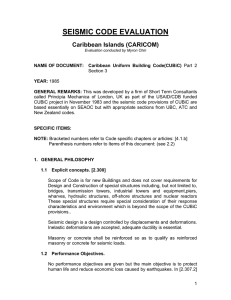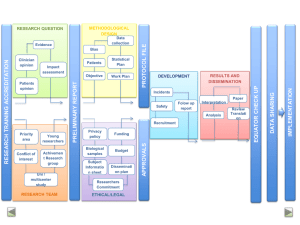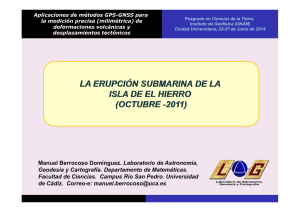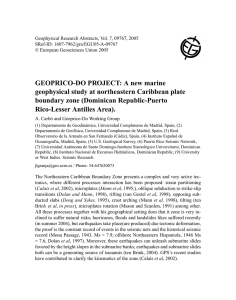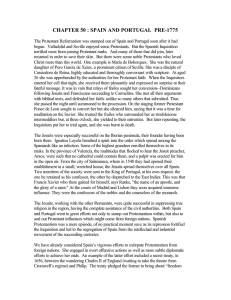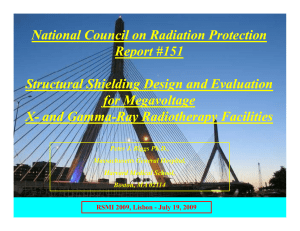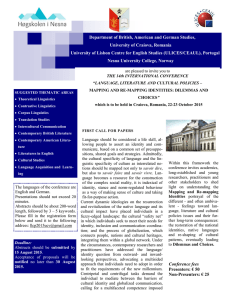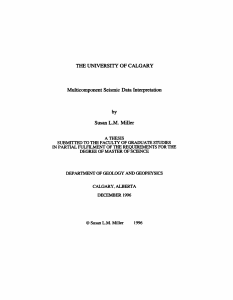Overview of Eurocode 8
Anuncio
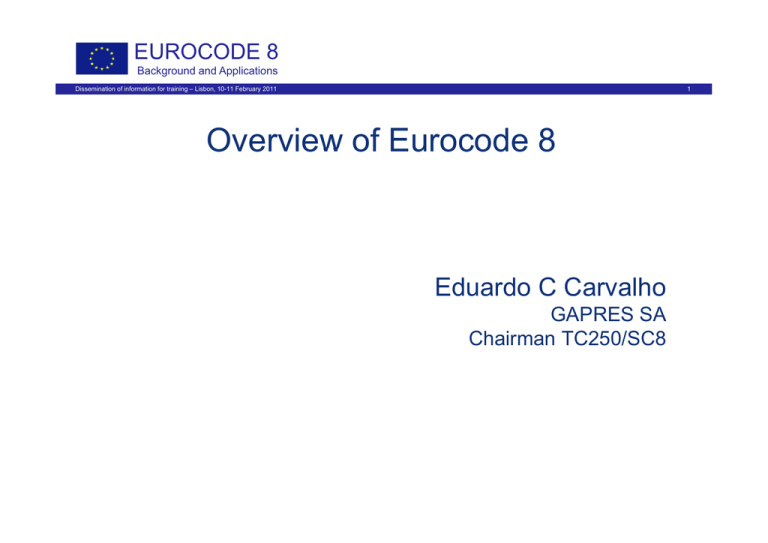
EUROCODE 8 Background and Applications Dissemination of information for training – Lisbon, 10-11 February 2011 1 Overview of Eurocode 8 Eduardo C Carvalho GAPRES SA Ch i Chairman TC250/SC8 Structural Eurocodes Dissemination of information for training – Lisbon 10-11 February 2011 • EN1990 Eurocode: Basis of structural design • • • • EN1991 Eurocode 1: Actions on structures EN1992 Eurocode 2: Design of concrete structures EN1993 Eurocode 3: Design of steel structures EN1994 Eurocode 4: Design of composite steel and concrete structures • • • • EN1995 Eurocode 5: Design of timber structures EN1996 Eurocode 6: Design of masonry structures EN1997 Eurocode 7: Geotechnical design EN1998 Eurocode 8: Design of structures for earthquake resistance • EN1999 999 Eurocode 9 9: Design g of aluminium structures Published by CEN (2004-2006) 2 Nationally Determined Parameters Dissemination of information for training – Lisbon 10-11 February 2011 3 Parameters which are left open in the Eurocodes for national choice c o ce ((NDPs s - Nationally at o a y Determined ete ed Parameters): a a ete s) • values and/or classes where alternatives are given in the Eurocode Eurocode, • values to be used where a symbol only is given in the Eurocode, • country specific data (geographical, climatic, etc.), e.g. snow map, • the procedure to be used where alternative procedures are given in the Eurocode. It may also contain • decisions on the application of informative annexes annexes, • references to non-contradictory complementary information to assist the user to apply the Eurocode. To be defined in the National Annexes Eurocode 8 - Design of structures for earthquake resistance Dissemination of information for training – Lisbon 10-11 February 2011 • EN1998-1: EN1998 1: General rules, rules seismic actions and rules for buildings • EN1998-2: Bridges • EN1998-3: Assessment and retrofitting of buildings • EN1998-4: Silos, tanks and pipelines • EN1998-5: Foundations, retaining structures and geotechnical aspects • EN1998-6: Towers, masts and chimneys y 4 Dissemination of information for training – Lisbon 10-11 February 2011 EN1998-1: General rules, seismic actions and rules for buildings EN1998-1 to be applied in combination with other Eurocodes 5 EN1998-1: General rules, seismic actions and rules for buildings Dissemination of information for training – Lisbon 10-11 February 2011 Contents of EN 1998-1 • • • • • General Performance requirements and compliance criteria Ground conditions and seismic action Design of buildings Specific rules for: g Concrete buildings Steel buildings Composite Steel-Concrete buildings Timber buildings Masonry buildings • Base isolation 6 Nationally Determined Parameters Dissemination of information for training – Lisbon 10-11 February 2011 7 Nationally y Determined Parameters ((NDPs)) in EN 1998-1: General aspects and definition of the seismic action: 11 Modelling analysis and design of buildings: Modelling, 7 Concrete buildings: 11 St l buildings: Steel b ildi 6 Composite buildings: 4 Timber buildings: 1 Masonry buildings: 15 Base isolation: 1 TOTAL 56 Objectives Dissemination of information for training – Lisbon 10-11 February 2011 Objectives of seismic design according to Eurocode 8 In the event of earthquakes: Human lives are protected Damage is limited Structures important for civil protection remain operational Special p structures – Nuclear Power Plants,, Offshore structures, Large Dams – outside the scope of EN 1998 8 Fundamental requirements Dissemination of information for training – Lisbon 10-11 February 2011 No-collapse p requirement: q Withstand the design seismic action without local or global collapse Retain structural integrity g y and residual load bearing capacity after the event Requirement R i t related l t d tto th the protection t ti off life lif under d a rare eventt through the prevention of local or global collapse. After the event a structure may economically unrecoverable but should ensure safe evacuation protection against after shocks Requirement associated with the Ultimate Limit State (ULS) in the framework of the Eurocodes 9 Fundamental requirements Dissemination of information for training – Lisbon 10-11 February 2011 No-collapse No collapse requirement: For ordinary structures this requirement should be met for a reference seismic action with 10 % probability of exceedance in 50 years (recommended value) i.e. with 475 years Return Period 10 Fundamental requirements Dissemination of information for training – Lisbon 10-11 February 2011 Damage limitation requirement: Withstand a more frequent seismic action without damage Avoid limitations of use with high costs Requirement related to the reduction of economic losses in frequent earthquakes (structural and non-structural). The structure should not have permanent deformations and its elements should retain its original strength and stiffness with no need for structural repair repair. Non-structural Non structural damages repairable economically. Requirement associated with the Serviceability Limit State (SLS) in the framework of the Eurocodes 11 Fundamental requirements Dissemination of information for training – Lisbon 10-11 February 2011 Damage limitation requirement: For ordinary structures this requirement should be met for a seismic action with 10 % probability of exceedance in 10 years (recommended value) i.e. with 95 years Return Period 12 Reliability differentiation Dissemination of information for training – Lisbon 10-11 February 2011 Target reliability of requirement depending on consequences of failure Classify the structures into importance classes Assign a higher or lower return period to the design seismic action In operational terms multiply the reference seismic action by the importance factor I 13 Importance classes for buildings Dissemination of information for training – Lisbon 10-11 February 2011 Importance classes for buildings 14 Importance factor and return period Dissemination of information for training – Lisbon 10-11 February 2011 At most sites the annual rate of exceedance, H(agR), of the reference peak ground acceleration agRR may be taken to vary with agR as: H(aggR ) ~ k0 aggR-k with the value of the exponent k depending on seismicity, but being generally of the order of 3 3. If the seismic action is defined in terms of the reference peak ground acceleration agR, the value of the importance factor I multiplying the reference seismic action to achieve the same probability of exceedance in TL years as in the TLR years for which the reference seismic action is defined, may be computed as I ~ (TLR/TL) –1/k. 15 Importance factor and return period Im mportance fa actor I Dissemination of information for training – Lisbon 10-11 February 2011 16 2.50 2.00 I = 1,4 , I = 1,2 1.50 1.00 k = 2,5 I = 0,8 k = 3 (EN1998-1) k=4 0.50 0.00 0 250 500 750 1,000 1,250 1,500 1,750 2,000 Return Period Importance factors for buildings (recommended values): I = 0,8 (I); 1,0 (II); 1,2 (III) and 1,4 (IV) Reduction factor (recommended values) to account for the lower return period for damage limitation verification: = 0,4 (III and IV) or 0,5 (I and II) Compliance criteria Dissemination of information for training – Lisbon 10-11 February 2011 Ultimate limit state (ULS) The resistance and energy-dissipation energy dissipation capacity to be assigned to the structure are related to the extent to which its non-linear response is to be exploited In operational terms such balance between resistance and energy-dissipation capacity is characterised by the values of the behaviour factor q and the associated ductility classes 17 Compliance criteria Dissemination of information for training – Lisbon 10-11 February 2011 Ultimate U t ate limitt state (U (ULS) S) As a limiting case, for the design of structures classified as low-dissipative, low dissipative no account is taken of any hysteretic energy dissipation and the behaviour factor may not be taken, in general, as being greater than the value of 1,5 considered to account for overstrengths For dissipative structures the behaviour factor is taken as being greater than this limiting values, accounting for the hysteretic energy dissipation that mainly occurs in specifically designed zones called dissipative zones or critical regions zones, 18 Compliance criteria Dissemination of information for training – Lisbon 10-11 February 2011 19 Design verifications Ultimate limit state (ULS) R i t Resistance and d Energy E dissipation di i ti capacity it Ductility classes and Behaviour factor values Overturning and sliding stability check Resistance of foundation elements and soil Second order effects Non detrimental effect of non structural elements Simplified checks for low seismicity cases (ag < 0,08 g) N application No li ti off EN 1998 ffor very low l seismicity i i it cases (a ( g < 0,04 0 04 g)) Compliance criteria Dissemination of information for training – Lisbon 10-11 February 2011 20 Design verifications Damage limitation state (DLS/SLS) Deformation limits (Maximum interstorey drift due to the “frequent” earthquake): • 0,5 % for brittle non structural elements attached to the structure • 0,75 % for ductile non structural elements attached to the structure • 1,0 % for non structural elements not interfering with the structure Sufficient stiffness of the structure for the operationality of vital services and equipment DLS may control the design in many cases Compliance criteria Dissemination of information for training – Lisbon 10-11 February 2011 21 Design verifications Take Specific Measures intended to reduce the uncertainty and promote a good behaviour of the str ct re e structure, even en under nder seismic actions more severe than the design seismic action Implicitly equivalent to the satisfaction of a third performance requirement: Prevention of global collapse under a very rare event (1.500 to 2.000 years return period). Denoted Near Collapse (NC) Limit State in EN 1998-3, very close to the actual collapse of the structure and corresponds to the full exploitation l it ti off the th deformation d f ti capacity it off the th structural t t l elements l t Compliance criteria Dissemination of information for training – Lisbon 10-11 February 2011 22 Specific measures Simple and regular forms (plan and elevation) Control the hierarchy of resistances and sequence q of failure modes ((capacity p y design) g ) Avoid brittle failures Control the behaviour of critical regions (detailing) Use adequate structural model (soil deformability and non strutural elements if appropriate) In zones of high seismicity formal Quality Plan for Design, Design Construction and Use is recommended
